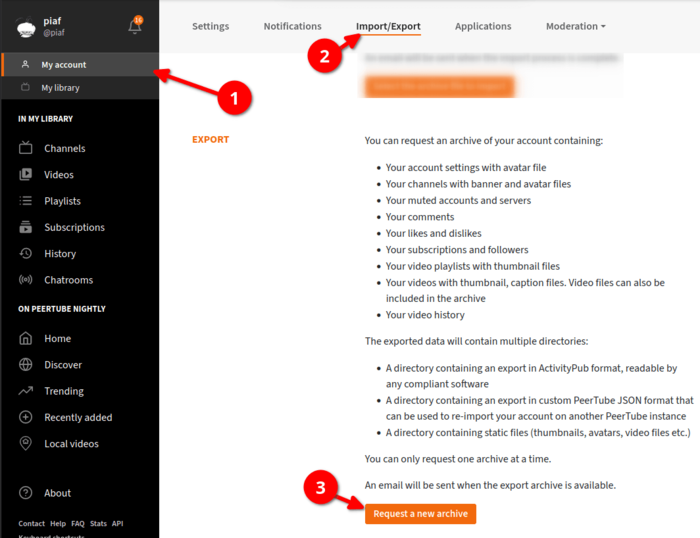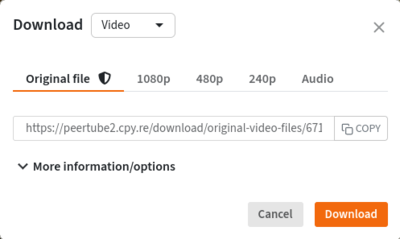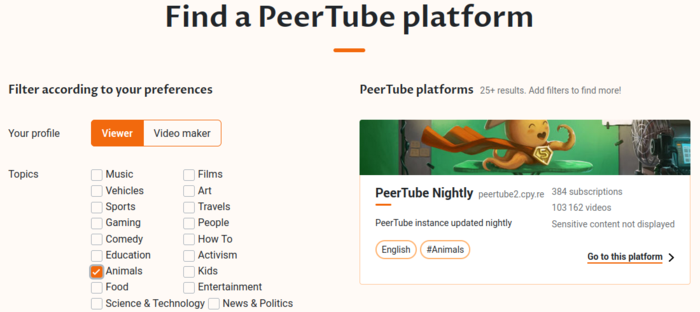Held release of a decentralized platform for organizing video hosting and video broadcasting PeerTube 6.1. PeerTube offers a vendor-neutral alternative to YouTube, Dailymotion and Vimeo, using a content distribution network based on P2P communications and linking visitors' browsers together. Project developments spread licensed under AGPLv3.
Advertisement
- It is possible to export all data associated with an account, including videos, channels and settings. Data is exported in the form of a single downloadable archive that can be used for import on another system.
- It is possible to save the original video file that was originally uploaded to PeerTube and then transcoded into other formats (previously, the original file was deleted after recoding). The added feature allows you to use PeerTube to store your video archives, without dividing into local and external videos.
- Added the ability to create a banner for your server, which will be displayed on the page about the server, on the login page, during registration and when searching in the JoinPeerTube directory, as well as on pages that use the “peertube-instance-banner” tag. Similarly, the ability to add an avatar has been added, apparently in the mobile application and on the server home page.
- The delay before starting to count video views has been reduced from 30 to 10 seconds, similar to Vimeo, Instagram, TikTok and Mux. When counting views, not only the IP address is now taken into account, but also the browser ID. On the page with viewing statistics, data is displayed in relation to individual regions, and not just to countries.
- To simplify access to subtitles, a separate “CC” button has been added to the video player (7 in the screenshot below), when clicked, subtitles will be displayed in the last selected language. It is also possible to change the language through the settings menu (8 in the screenshot).
- The user interface provides the ability to download videos directly from the library.
- For the administrator, the ability to sort users and videos by the size of data stored on disk has been added.
- Two vulnerabilities in the implementation of the ActivityPub protocol have been fixed. The first vulnerability leaks data associated with private videos, such as comments and likes. The second vulnerability concerns incorrect access control to JSON-LD objects loaded from the federated network.
The PeerTube platform was originally based on the use of the BitTorrent client WebTorrent, launched in the browser and using technology WebRTC to organize a direct P2P communication channel between browsers. Later, instead of WebTorrent, the HLS (HTTP Live Streaming) protocol was used in conjunction with WebRTC, which allows adaptive control of the stream depending on the bandwidth. The ActivityPub protocol is used to unite disparate video servers into a common federated network in which visitors participate in content delivery and have the ability to subscribe to channels and receive notifications about new videos. The web interface provided by the project is built using the framework Angular.
The PeerTube federated network is formed as a community of interconnected small video hosting servers, each of which has its own administrator and can adopt its own rules. Each server with video acts as a BitTorrent tracker, which hosts user accounts of this server and their videos. The user ID is formed in the form “@user_name@server_domain”. Browsing data is transmitted directly from the browsers of other visitors viewing the content.
If no one views the video, the upload is organized by the server to which the video was originally uploaded (the protocol is used WebSeed). In addition to distributing traffic among users watching videos, PeerTube also allows nodes launched by creators to initially host videos to cache videos from other creators, forming a distributed network of not only clients but also servers, as well as providing fault tolerance. There is support for live streaming with content delivery in P2P mode (standard programs such as OBS can be used to control streaming).
To start broadcasting via PeerTube, the user just needs to upload a video, description and a set of tags to one of the servers. After this, the video will become available throughout the federated network, and not just from the initial download server. To work with PeerTube and participate in content distribution, a regular browser is sufficient and does not require installation of additional software. Users can track activity in selected video channels by subscribing to channels of interest in federated social networks (for example, Mastodon and Pleroma) or via RSS. To distribute videos using P2P communications, the user can also add a special widget with a built-in web player to his website.
Advertisement
Currently functioning for posting content 1126 servers maintained by various volunteers and organizations. If a user is not satisfied with the rules for posting videos on a particular PeerTube server, he can connect to another server or run your own server. For quick server deployment, a pre-configured image in Docker format (chocobozzz/peertube) is provided.
Thanks for reading:



